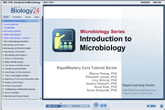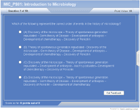| How to Learn in 24 Hours? |
|
| Need Help? |
M-F: 9am-5pm(PST):
Toll-Free: (877) RAPID-10
US Direct: (714) 692-2900
Int'l: 001-714-692-2900
24/7 Online Technical Support:
The Rapid Support Center
Secure Online Order:

|
| Tell-A-Friend: |
Have friends taking science and math courses too? Tell them about our rapid learning system.
|
|
Introduction to Microbiology
| Topic Review on "Title": |
- Microbiology is the study of microorganisms which must be viewed with the aid of a microscope or electron microscope.
- The importance of microbiology includes: used in biomedical research, creation of medicines, environmental applications and new research tools.
- Disease causing organisms include: protists, bacteria, viruses and other microorganisms.
- Bacteria are important for fixing N2 in a usable form for plants.
- Bacteria and some fungi are important in decomposition and recycling of raw materials.
- Industry applications of microbiology: waste management, food industry, mining, medicine, research and biotechnology.
- 1660’s Robert Hooke observed microorganisms for the first time with a microscope and coined the term “cell”.
- 1632-1723 Anton van Leeuwenhoek credited with having observed the first bacteria.
- 1828-1898 Ferdinand Cohn developed the first classification scheme based on bacteria shape. Cohn detailed and described the life cycle of Bacillus.
Cohn’s Classification System:
- Sphaerobacteria are spherically shaped.
- Microbacteria are rod shaped
- Desmobacteria are filamentous
- Spirobacteria are spiral shaped
- 1822-1895 Louis Pasteur Defined pasteurization to prevent spoilage of food by bacteria, develop vaccines and disproved the scientific dogma of “Spontaneous Generation”. He defined “Germ Theory” and demonstrated that germs were responsible for disease.
- 1843-1910 Robert Koch identified anthrax and developed agar growth medium. Koch’s postulates was a systematic method to establish the microbial cause of disease.
- Ignaz Semmelweis was the first to recognize the need for good hygiene during medical procedures. The first to identify nosocomial infections.
- 1827-1912 Joseph Lister developed antiseptic methods for use in surgery and medicine.
- 1854-1915 Paul Ehrlich developed chemotherapy to cure infectious diseases and discovers antibiotics to treat sleeping sickness and syphilis.
- 1881-1951 Alexander Fleming discovered penicillin and lysozyme.
- 1864-1920 Dmitri Ivansvski discovered the first virus which is known as the tobacco mosaic virus (TMV).
- 1952 Hershey & Chase Experiments identified that DNA was the genetic material of bacteriophages.
- Hershey Case Experiment: using phage radioactively labeled with P32 (DNA) or S35 (protein) they infected bacteria cells. They found the P32 inside the bacteria not S35.
Recommendations for Success in Microbiology
- Successful completions of general biology 2 semesters
- Knowledge of basic chemistry and biochemistry
- Basic understanding of classification
- Review layout of text book used in the course.
- Read and master learning objectives laid out in the text book.
- Master definitions presented in the course.
|
| Rapid Study Kit for "Title": |
| Flash Movie |
Flash Game |
Flash Card |
| Core Concept Tutorial |
Problem Solving Drill |
Review Cheat Sheet |
 |
 |
 |
|
| "Title" Tutorial Summary : |
The history, scope and methodology of microbiology are introduced. Microbiology is the study of microorganisms which include: bacteria, viruses, viroids, yeast, molds, protozoans, algae, fungi and other very small organisms. Microbiology is important because it helps us to understand and treat diseases. It also is important economically because it impacts the environment, research fields and biotechnology.
The suggested prerequisites for the successful completion of microbiology is two semesters each of basic biology and chemistry. Master definitions as they are presented this will lead to an easier acquisition of concepts.
|
| Tutorial Features: |
Specific Tutorial Features:
- Define the field of Microbiology.
- Elucidate the importance of the science of microbiology.
- Review the history and the importance of the major milestones of microbiology.
- Demonstrate the relationship between microbiology and other disciplines of biology.
- Describe the methods used in the study of microbiology.
Series Features:
- Concept map showing how microbiology relates to other fields of biology.
- Definition slides introduce terms as they are needed.
- Visual representations of microbiology milestones.
- Outline for the successful study of microbiology.
- A concise summary is given at the conclusion of the tutorial.
|
| "Title" Topic List: |
Microbiology is the study of microorganisms.
Microorganisms are too small to see with the naked eye.
Microbiology may include single celled or multi-cellular organisms.
Microbiology and its methods are used in very diverse areas of research, study and applications. Other inter-related fields include: medicine, biotechnology, environmental research, genetics and others.
The history of microbiology is described and important milestones detailed.
|
See all 24 lessons in Anatomy and Physiology, including concept tutorials, problem drills and cheat sheets:
Teach Yourself Microbiology Visually in 24 Hours
|



